Abstract
The Whole School, Whole Community, Whole Child (WSCC, pronounced “wisk”) Model is an ideal framework for school communities to assess, plan and implement healthy school policies in a coordinated fashion. Erika’s Lighthouse supports this model in its attempt to create cultural change within schools to boost the physical and mental health of students. Erika’s Lighthouse programs support the creation of a school environment that strengthens mental health by working across the WSCC model components.
What is the WSCC model?
The Centers for Disease Control and Prevention (CDC) developed the WSCC framework in order to provide a student-centered and community-oriented approach to addressing health in schools. This model emphasizes the important link between healthy living and success in the classroom for students and their school community. The WSCC model brings together the public health, education and school health sectors in order to better serve the whole child. (1)
The goals of the WSCC model are:
In order to achieve these goals, the WSCC model has identified 10 components that must be present in a school community:
Mental Health and WSCC – How does it fit?
The WSCC model places the student at its core. The intention is for each student to be healthy, safe, supported, challenged, and engaged. By unifying the concepts of general public health and education, students are given the ability to thrive and grow as healthy human beings through “greater alignment that includes, integration and collaboration between education leaders and health sectors to improve each child’s cognitive, physical, social, and emotional development.” Addressing the mental health needs of students is an opportunity to improve health and academic outcomes of young people. The WSCC framework is a framework to promote good mental health in schools through multidisciplinary collaboration that creates inclusive cultures, identifies struggling students and implements effective interventions.
Erika’s Lighthouse: A Beacon of Hope for Adolescent Depression is a non-profit organization that develops curricula and lesson plans for depression education and suicide prevention in schools. Since 2004, Erika’s Lighthouse has worked with administrators, classroom educators, school counselors and school social workers to empower and educate their students to take control of their mental health and learn how to seek help for themselves or a friend. The Erika’s Lighthouse programs firmly center on the student, allowing teens to find their voices and speak up about mental health. By building up students in their school, teens have the ability to share their knowledge with the community around them, and in turn create a whole school and whole community that support their physical and mental health. These building blocks are sure to provide students the foundation to succeed and excel academically and socially.
If students aren’t feeling well (physically or mentally), they can’t be expected to do well academically. Erika’s Lighthouse inherently embraces the concepts behind WSCC and is an ideal mental health partner to help achieve the four goals. Since its inception, Erika’s Lighthouse has focused on merging the efforts of students, school staff, families and community members to combat the stigma around mental health. We encourage schools to collaborate with various departments when focusing on mental health and, ideally, host all-staff trainings on the topics of depression and suicide. It is especially beneficial for educators to co-teach the Erika’s Lighthouse programs with someone from the mental health or student support services departments, such as school social workers, school psychologists or school counselors. The Erika’s Lighthouse programs provide students with tools they need to gain depression literacy, knowledge and skills about what to do if concerned about themselves or a friend.
Implementing Erika’s Lighthouse Within the WSCC Framework
Erika’s Lighthouse Classroom Programs
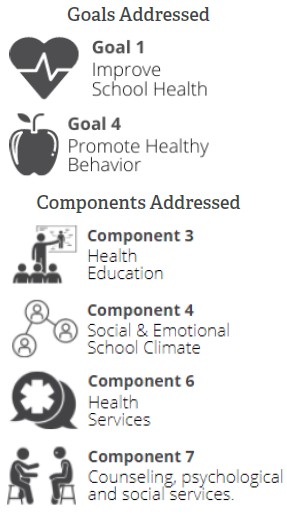 Erika’s Lighthouse Classroom Programs are inherently designed to improve school health and promote behaviors that improve or support health. This is accomplished through the following WSCC components:
Erika’s Lighthouse Classroom Programs are inherently designed to improve school health and promote behaviors that improve or support health. This is accomplished through the following WSCC components:
Component 3: Health Education
As a provider of Tier 1 universal depression education programs, Erika’s Lighthouse is ideally suited to be incorporated into a school’s efforts to embrace the WSCC framework. Through the Erika’s Lighthouse programs, students acquire the knowledge to be able to identify the signs and symptoms of depression, change attitudes regarding stigma around mental health challenges, and develop help-seeking skills.
A health education classroom is often the place in a school’s curriculum where mental health, depression and suicide prevention are most directly addressed. Therefore, ensuring the program meets National Health Education Standards, which incorporate skills-based learning, is key to continued promotion of help-seeking behavior.
“Today’s state-of-the-art health education curricula reflect the growing body of research that emphasizes:
- Teaching functional health information (essential knowledge).
- Shaping personal values and beliefs that support healthy behaviors.
- Shaping group norms that value a healthy lifestyle.
- Developing the essential health skills necessary to adopt, practice, and maintain health-enhancing behaviors” (2).
Erika’s Lighthouse programs are skills-based and designed to provide opportunities for students to achieve healthy behavioral outcomes. These skills-based lessons help students learn to self-identify if they are struggling.
Skills-based education is designed to not only educate students with knowledge but, possibly more importantly, empower them with the tools and skills to act upon that information through a participatory learning experience that includes role-playing, practice and modeling behaviors.
Traditional knowledge-based delivery of suicide and mental health topics may “check the boxes,” but as adolescents change and grow, so do their experiences, challenges and well-being. Therefore, skills-based education is especially helpful, so students can take away actionable tools to use beyond the classroom.
Erika’s Lighthouse programs are designed to not only teach students how to access valid information and services throughout their lives (National Health Education Standard #3), but provide them the opportunity to practice doing so. The ability of a student to know how to self-identify and seek help is key to a district’s suicide prevention and mental health education. The larger goal is that a lesson delivered in ninth grade has the potential to instill a student’s ability to access necessary services when needed, even years down the road.
 The Erika’s Lighthouse programs address the following National Health Education Standards (3):
The Erika’s Lighthouse programs address the following National Health Education Standards (3):
- #1: Students will comprehend concepts related to health promotion and disease prevention to enhance health.
- #3: Students will demonstrate the ability to access valid information, products, and services to enhance health.
- #4: Students will demonstrate the ability to use interpersonal communication skills to enhance health and avoid or reduce health risks.
- #7: Students will demonstrate the ability to practice health-enhancing behaviors and avoid or reduce health risks.
Integrating health-promoting behaviors into our lives is key to good mental health. The Erika’s Lighthouse programs address positive coping skills and allow students to explore and practice what types of self-care help them in challenging situations. Going through the actions of self-care and identifying positive coping strategies is an important piece of skills-based mental health education, and these programs let students practice learned skills.
Recognizing the importance of mental health education as central to wellness promotion efforts will increase the ability for students to remain healthy – both mentally and physically.
Component 4: Social & Emotional School Climate
Erika’s Lighthouse strives to help schools build inclusive communities and a climate that supports positive social and emotional development. The Erika’s Lighthouse programs focus on helping students to use their voice in ways that reduce stigma associated with talking about mental health. This is done by empowering students to use their voices to talk about mental health by providing them with a common vocabulary and a shared understanding of what constitutes good mental health. This allows students to identify trusted adults, learn how to talk to a friend, and develop language to ask for help for themselves and others they are concerned about. Teachers and staff can also promote a safe help-seeking environment by using the “I’m a Beacon of Hope” sign, available on the Erika’s Lighthouse Resource Portal, to let students know they have trustworthy and supportive adults to turn to.
The programs encourage students to make changes in their school environment and build a stigma-free school climate; thus improving school health.
Component 6: Health Services
With a rapidly changing world school systems, families and communities often must adjust. Remote and distance learning environments have become more common, and with students potentially being more isolated, it is important for young people to learn that there are still ways to ask for help.
When students can identify where to seek help in school, they feel safe and connected. The Erika’s Lighthouse programs utilize Self-Referral Cards, which offer students the opportunity to recognize that they might need to speak with someone and indicate that they’d like to be connected to a health service provider or mental health professional in the building.
The safety of all students is taken into consideration in both the WSCC model and the Erika’s Lighthouse resources, and schools should have an appropriate crisis plan in place. Classroom teachers or school nurses are often the ones who recognize that a student is struggling even if it is not their job to diagnose or provide treatment. Erika’s Lighthouse supports a school’s efforts in outlining what to do if a student is in need by informing students who the health service providers (school nurses, social workers, psychologists) are in the school building and where they are located.
Component 7: Counseling, Psychological & Social Services
What is unique about Erika’s Lighthouse is that the programs let students use their voice to self-advocate by learning to ask for help. By using Self-Referral Cards, students needing support can be connected with counseling, psychological and/or social services.
In addition, educators are encouraged to use Erika’s Lighthouse bookmarks, which are a takeaway for students where they can both write down the name of a trusted adult, and also identify where in their school or community they can go for help (for example, a community health center or the school social worker’s office).
By employing these methods and others, students learn that they can overcome the various barriers that exist with regards to seeking help. Learning who the appropriate school counselor, social worker or psychologist is, or identifying other community resources, allows students to see that help is available, there are adults who care and there is no shame in speaking up.
Teen Empowerment Clubs and Awareness Into Action Activities
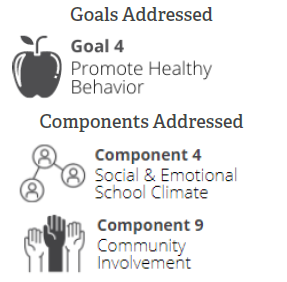 Teen Empowerment Clubs and their associated Awareness Into Action Activities were created to promote health behaviors within school communities through peer-led initiatives. This can be accomplished through these WSCC components:
Teen Empowerment Clubs and their associated Awareness Into Action Activities were created to promote health behaviors within school communities through peer-led initiatives. This can be accomplished through these WSCC components:
Component 4: Social & Emotional School Climate
Outside of the classroom programs, which educate students about depression and also promote positive messaging about general mental health, Teen Empowerment Clubs are all about creating an inclusive school climate by eliminating stigma. Teen Empowerment Clubs and Awareness Into Action Activities, which allow students to be leaders in their school, are designed to take the education and awareness gained in the classroom and activate their peers to make changes to their school climate.
60% to 80% of young people do not receive the necessary treatment (4) to manage their mental illness, and stigma is a top reason for that. By building a school culture that allows students to not feel ashamed and to promote a supportive community, stigma around mental health challenges can be broken down – creating more inclusive social and emotional climates.
Component 9: Community Involvement
While depression education programs are implemented within a school building, the intention is for the awareness to expand outside of those walls and permeate into the community. In addition, the schools cannot be expected to have the capacity to meet all student needs and must rely on appropriate community partners. By giving students a voice, they are able to take that knowledge and empowerment to their larger community. Erika’s Lighthouse offers the opportunity for schools and students to create their own knowledge-building and stigma-busting events such as Beacon of Hope Community Fun Run/Walks, Shine Bright Neon Dance Relays, and customizable Shine A Light fundraisers.
Family Engagement
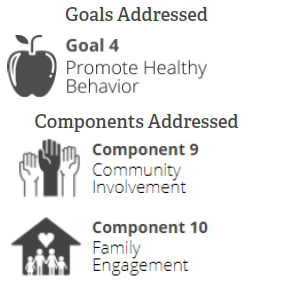 Family Engagement activities are a key pillar of the Erika’s Lighthouse program. A barrier for students seeking mental health support often begins at home due to a lack of knowledge and understanding from parents or caregivers. Erika’s Lighthouse works to alleviate this by promoting healthy behaviors at home through the following WSCC components:
Family Engagement activities are a key pillar of the Erika’s Lighthouse program. A barrier for students seeking mental health support often begins at home due to a lack of knowledge and understanding from parents or caregivers. Erika’s Lighthouse works to alleviate this by promoting healthy behaviors at home through the following WSCC components:
Component 10: Family Engagement
The Parent Handbook on Childhood & Teen Depression is a practical approach for parents and caregivers who might be navigating depression with their teenager. This book was written by parents for parents, and offers tips and information on how to help a young person who might be struggling.
In 2020, Erika’s Lighthouse expanded its materials so that schools could provide parents and caregivers with more resources to help talk about good mental health and what to look for in the event a child is struggling. These materials, such as the Depression Discussion Guide, Language for Parents During Times of Worry, and the Shared Vocabulary sheets, are intended to help families learn more about what their child is learning at school and provide them with the tools and language they need to be able to talk about the topics at home. Additionally, schools are encouraged to send home a Parent Letter, to let adult caregivers know that their child will be learning about sensitive topics and offer them an opportunity to further that learning at home.
Through a collaboration called Shine Light on Depression, in association with Anthem, Inc., JetBlue Airways, National PTA and the American School Health Association, Family Night Workshops are also available to school communities to engage and educate parents on mental health issues impacting adolescents.
Component 9: Community Involvement
Similar to efforts listed above, community involvement inherently engages parents and family members in school activities such as building a shared vocabulary, utilizing Awareness Into Action Activities, hosting Beacon of Hope Community Walks & Fun Runs and other inspiring events. These types of events and open conversations within a community can lend themselves to educating the general public about mental health, breaking down the stigma, and letting all community members know that help and hope are available.
Professional Development & School Policy
 Creating inclusive and healthy school communities requires collaboration from all members of the school community – from students and educators to administrators and support staff. Erika’s Lighthouse aims to achieve community-building by improving school health and promoting healthy behavior with professional development and effective school policies through the following WSCC components:
Creating inclusive and healthy school communities requires collaboration from all members of the school community – from students and educators to administrators and support staff. Erika’s Lighthouse aims to achieve community-building by improving school health and promoting healthy behavior with professional development and effective school policies through the following WSCC components:
Component 4: Social & Emotional School Climate
School climate is not just created by students, but staff and other adults in the school community have an impact as well. The Erika’s Lighthouse Professional Development resources can help align depression education lessons with all-staff depression and suicide prevention training, thus creating a web of support throughout the school. Breaking down stigma in a building requires educators to be prepared to help teens who are struggling. This training supports a school’s efforts in outlining what to do if a student is in need.
In addition, Erika’s Lighthouse encourages and informs schools to ensure that plans are in place should a student be in crisis. Developing strong school policies and procedures in these matters will support both staff and student development, confidence and response. Following the Model School Policy for Suicide Prevention is a great start to aligning staff around mental health and suicide prevention – and Erika’s Lighthouse can assist with that.
Component 6: Health Services
The safety of all students is taken into consideration in both the WSCC model and the Erika’s Lighthouse program materials, and schools should have an appropriate crisis plan in place.
Some of the prevention and intervention materials available through Erika’s Lighthouse for professional development efforts include student Self-Referral Cards, sample intervention language for educators (including for remote interventions), along with vocabulary and discussion guides. If educators use the Self-Referral Cards, support and health services staff in the building should be made aware so that they may be prepared for a potential increase in the number of students asking to speak with someone. By preparing staff members and providing the appropriate training, the school building will be able to better promote healthy behavior and thus demonstrate a focus on school health.
Professional Development and staff training is meant to align all staff, including health service providers, to ensure a common vocabulary, shared experience and knowledge. Health service providers are often front-line employees seeing many initial signs and symptoms of a student’s depression or mental health challenges. Recognizing those signs and knowing how to respond effectively is key to identifying and supporting struggling students.
In addition, schools need to ensure policies and procedures include effective collaboration and communication between school health teams – both physical and mental – so struggling students can be identified and supported.
Component 7: Counseling, psychological and social services
The implementation of Erika’s Lighthouse programs also supports the early identification of students struggling with depression and suicidal ideation – but utilizes depression as a “gateway conversation” around mental health to reduce stigma and encourage students with stress, anxiety and other mental health challenges to self-identify and seek support.
Aligning Values
In addition to the Erika’s Lighthouse programs aligning closely to the goals and components of the WSCC model, so do the values embraced by both WSCC and Erika’s Lighthouse.
The WSCC Model believes in:
The impact of student-centered initiatives
Erika’s Lighthouse programs are teen-oriented and highlight real stories from real teens. The adolescent-focused program videos are not scripted and the students are not actors; this allows for a peer-to-peer type approach that focuses on connecting with the students in the classroom. The diversity and representation demonstrated throughout the program allows young people the opportunity to connect with someone like them.
These student-centered initiatives extend to out-of-school time opportunities like the Teen Empowerment Clubs, Awareness into Action Activities, Family Engagement activities, community building opportunities and more.
The components of the WSCC Model all center around the student. Putting the student in the center allows the whole child to be impacted and takes into consideration the links between health, education and community. “The relationship between the school and the community affects the entire community, not just the students attending the school. The WSCC model includes these contexts because research has shown their impact on education and health outcomes” (5).
The role of the community in supporting the school
Erika’s Lighthouse promotes the model school policy by emphasizing the role of the community in supporting the school. Stigma is one of the primary barriers to teens reaching out for help. By educating about depression and letting students, parents, staff understand that it is a common, yet treatable, mood disorder, awareness will be spread throughout the community. By educating students and adults, communities can become stronger and more invested. Healthy students and successful students play a role in building stronger communities (6).
The connections between health and academic achievement
While physical health is important to maintain and linked to academic achievement, mental health must also be addressed and should be a focal point in health education. Depression accounts for many of the issues that impact a student’s ability to learn and perform any given day.
The importance of evidence-based school policies and practices.
Erika’s Lighthouse programs are evidence-informed and based on best practices. Believing a program is effective and having data that demonstrates it are very different. It is imperative for schools to ensure programs have and will accomplish the established objectives.
Conclusion
Erika’s Lighthouse depression education programming is uniquely qualified to assist in meeting the mental health needs of school communities. While physical and health education are a primary part of a school’s curriculum, the mental health education piece must be addressed with equal importance. By incorporating depression education with suicide prevention and promoting good mental health, school districts are able to center around the whole child and create a more inclusive and well-rounded school community. The Erika’s Lighthouse programs seamlessly weave into the WSCC model goals and components and can help schools build positive mental health cultures to ensure the safety and well-being of all students.
Visit www.ErikasLighthouse.org to access free resources for your school community.
Contributors
Author:
Kristina Kins, MSW, Director of Program Development & Operations, Erika’s Lighthouse
Co-Authors:
Holly Alperin, EdM, MCHES , University of New Hampshire and Lighthouse Wellness & Health Education Consulting
Jeanie Alter, PhD, MCHES, FASHA, Executive Director, American School Health Association (ASHA)
Brandon M. Combs, MNA, Executive Director, Erika’s Lighthouse
Peggy Kubert, LCSW, Senior Director of Education, Erika’s Lighthouse
Jessica Lawrence, Director, Cairn Guidance
Ilana Sherman, MPH, Director of Education, Erika’s Lighthouse
Reviewers:
Society of Health and Physical Educators (SHAPE America)
Lisa Honcharuk, Manager of Marketing & Engagement, Erika’s Lighthouse
Meade Means, Development & Operations Assistant, Erika’s Lighthouse
Sources
- https://www.cdc.gov/healthyschools/wscc/index.htm
- https://www.cdc.gov/healthyschools/sher/characteristics/index.htm
- https://www.cdc.gov/healthyschools/sher/standards/index.htm
- https://www.nimh.nih.gov/health/statistics/major-depression.shtml#part_155031
- http://www.ascd.org/ASCD/pdf/siteASCD/publications/wholechild/wscc-a-collaborative-approach.pdf.
- https://www.cdc.gov/healthyyouth/health_and_academics/pdf/health-academics-ppt.pdf

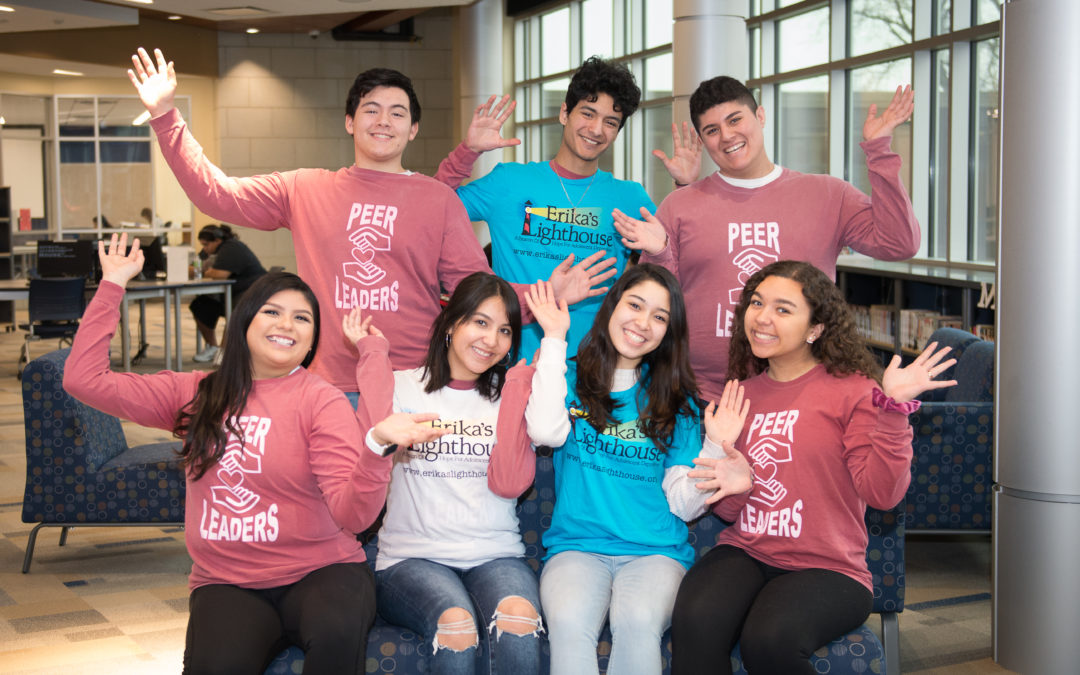



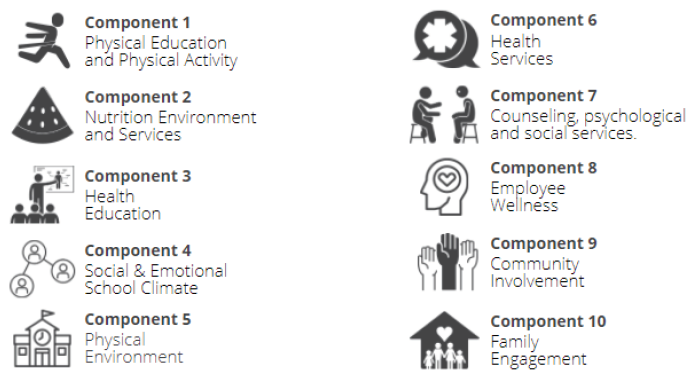

This is excellent 🙂
This is a amazing and big
You list 4 goals of the program. #1 is to “Improve School Health. #2 is to “Assess School Health” How can you improve school health without first assessing the level and current status of school health?
In fairness, I haven’t seem the curriculum, and have only seen the website and some of the attached resources. If Goal #1 is to Increase School Health without first assessing the current level of school health and current needs, I question the underlying motives of the program. It seems there is a preconceived notion of what school health should be. Goal #1 puts those ideas in place before even assessing what school health currently is.
How do you know you’re improving school health (Goal #1), without first assessing the current level of school health (Goal #2).
Thank you for reading Shane!
The goals you have listed are the goals of the WSCC model – not Erika’s Lighthouse. The White Paper is to demonstrate how the Erika’s Lighthouse, Tier-1 Mental Health Programs, can support and integrate within the national WSCC model.